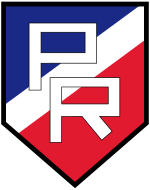Radical Party (Chile)
|
Radical Party
Partido Radical |
|
|---|---|
 |
|
| Leader (s) |
Manuel Antonio Matta, Ramón Allende Padín, Enrique Mac Iver, Juan Esteban Montero, Pedro Aguirre Cerda, Juan Antonio Ríos, Gabriel González Videla, Anselmo Sule |
| Founded | December 27, 1863 |
| Dissolved | August 18, 1994 |
| Split from | Liberal Party |
| Merged into | Social Democrat Radical Party |
| Headquarters | Santiago de Chile |
| Youth wing | Juventud Radical de Chile |
| Ideology |
Radicalism (Chile) Social liberalism |
| Political position | Centre |
| National affiliation |
Liberal Alliance (1891–1925) Popular Front (1937–41) Democratic Alliance (1942–47) Democratic Front (1962–64) Popular Unity (1969–73) Concertación (1988–94) |
| International affiliation | Socialist International (1981–94) |
| Colours | Blue, white, red |
The Radical Party (Spanish: Partido Radical) of Chile was a Chilean political party. It was formed in 1863 in Copiapó by a split in the Liberal Party. Not coincidentally, it was formed shortly after the organization of the Grand Lodge of Chile, and it has maintained a close relationship with Chilean Freemasonry throughout its life. As such, it represented the anticlericalist position in Chilean politics, and was instrumental in producing the "theological reforms" in Chilean law in the early 1880s. These laws removed the cemeteries from the control of the Roman Catholic Church, established a civil registry of births and death in place of the previous recordkeeping of the church, and established a civil law of matrimony, which removed the determination of validity of marriages from the church. Prior to these laws, it was impossible for non-Catholics to contract marriage in Chile, and meant that any children they produced were illegitimate. Non-Catholics had also been barred from burial in Catholic cemeteries, which were virtually the only cemeteries in the country; instead, non-Catholics were buried in the beaches, and even on the Santa Lucia Hill in Santiago, which, in the 19th century, functioned as Santiago's dump.
In the 20th century, the radicals adopted a moderately center-left stance, taking part to Pedro Aguirre Cerda's Popular Front and then to the Democratic Alliance left-wings coalition which succeeded to Cerda's death.
During the presidency of Gabriel Gonzalez Videla (1946–1952) it shifted to the right, and many of its members were anti-Communists. In 1950s, the party started to lose ground. At the end of the 1960s, left-wingers gained upper hand in the Radical party, causing some of the more right-wing leaders to leave the party. The anticommunist Radicals formed the Radical Democracy. In the crucial 1970 election, which resulted in the presidency of Salvador Allende, they formed an alliance with the right-wing National Party and, later, supported Pinochet's 1973 coup. In contrast, the Radical Party was part of the Unidad Popular coalition supporting Salvador Allende who became president in 1970. Radicals, supporting gradual reforms, were generally loyal to the leftist governing coalition.
...
Wikipedia
